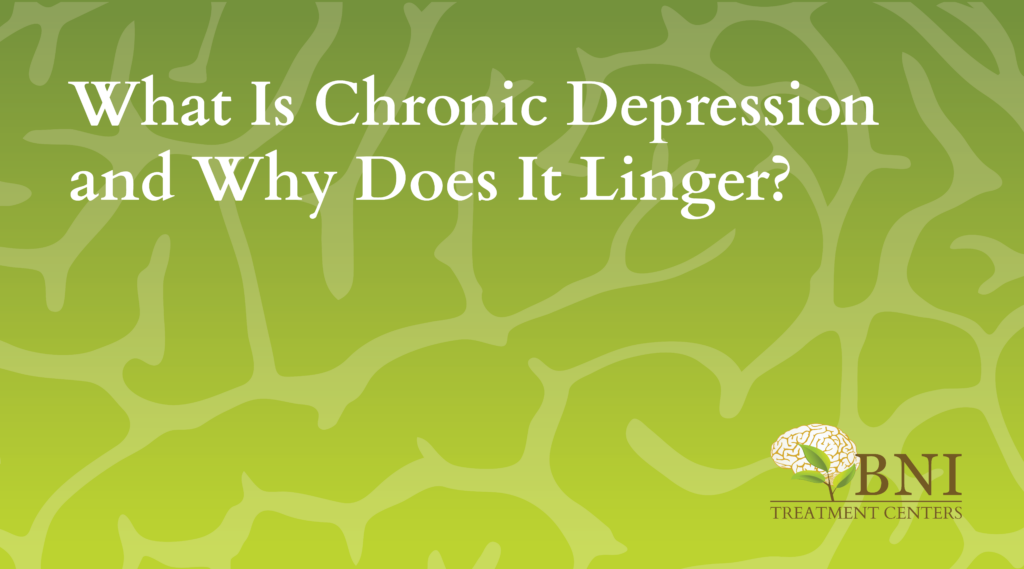
In Los Angeles County, the mental health of adolescents has become an increasingly pressing issue. A recent study from the UCLA Center for Health Policy Research reveals that 45% of adolescents aged 12–17 report experiencing symptoms of mental health conditions, including depression, marking a significant rise in recent years. This alarming trend underscores the importance of recognizing and addressing chronic depression among teens in our communities.
Recognizing the signs of chronic depression early is crucial for effective intervention. Symptoms may include persistent feelings of hopelessness, changes in appetite or sleep patterns, or a noticeable decline in academic performance or social interactions.
At BNI Treatment Centers, we are committed to providing comprehensive, evidence-based care tailored to the unique needs of each adolescent. Our multidisciplinary team works closely with teens and their families to develop personalized treatment plans aimed at fostering resilience and promoting long-term recovery.
Chronic Depression vs. Situational Sadness: What’s the Difference?
Chronic depression, which is also referred to as persistent depressive disorder (or PDD), is most usually defined by a sad, irritable, and generally low mood that lasts most of the day – more days than not – for at least one year in adolescents. Unlike temporary emotional dips (like those triggered by a breakup, academic stress, or emotionally charged social situations), chronic depression doesn’t lift easily with time or changes in circumstance. It’s not just about feeling sad; it’s about living in a state of ongoing emotional heaviness that impacts daily life, relationships, and self-worth.
By contrast, situational sadness is a more short-term emotional response to a very specific event. While it can feel intense, it can typically be resolved with support, learning new coping strategies, or even just giving the situation time to improve. Chronic depression, on the other hand, persists even when there’s no clear external trigger, and may continue despite a teen’s best efforts to feel better.
Teens coping with chronic depression might appear to function on the surface – attending school, socializing, and participating in activities – while quietly battling symptoms like low energy, hopelessness, irritability, and overall lack of motivation. They may be labeled as moody or unmotivated when, in reality, they’re stuck in a cycle that’s much deeper than ordinary sadness.
Other Kinds of Chronic Depression
Sometimes chronic depression isn’t so straightforward, and teens can experience variations that can make diagnosis and treatment more nuanced. In addition to persistent depressive disorder (PDD), here are a few other forms of depression to be aware of:
- Double Depression: A combination of persistent depressive disorder and major depressive episodes. Teens may have a chronic low mood (PDD) with periods of more intense symptoms (MDD), such as hopelessness, withdrawal, or suicidal thoughts.
- Dysthymia with Atypical Features: Symptoms may include increased sleep, increased appetite, and heightened sensitivity to rejection. These features can sometimes mask the underlying depression or be mistaken for normal teenage behavior.
- Chronic Major Depressive Disorder (MDD): In some cases, major depressive episodes don’t resolve within the expected timeframe. If a teen experiences an episode that lasts longer than a year without significant relief, it may be categorized as chronic MDD.
- Subclinical or Low-Grade Depression: Not all chronic emotional turmoils meet the full diagnostic criteria for a disorder, but persistent sadness, irritability, and fatigue over time can still impact quality of life and require attention.
These variations highlight the importance of professional assessment. Even if symptoms don’t fit neatly into one category, long-lasting emotional distress should never be ignored.
Why Does Chronic Depression Develop?
Chronic depression in teens doesn’t develop overnight. It often emerges from a complex blend of psychological, environmental, and even genetic influences. Understanding the potential causes can help parents, caregivers, and clinicians better support adolescents who may be silently coping on their own.
- Lack of Support or Connection: Teens who feel misunderstood, unsupported, and disconnected from their family or peers may experience more long-term emotional health issues. Social isolation – even in the presence of others – can fuel feelings of worthlessness, hopelessness, and persistent sadness.
- Brain Chemistry and Hormonal Changes: Imbalances in neurotransmitters like serotonin and dopamine – the brain chemicals that regulate mood and motivation – can contribute to the development of chronic depression. This is especially relevant during adolescence, when hormonal shifts and brain development are already in flux.
- Trauma and Adverse Childhood Experiences (ACEs): Teens who’ve experienced emotional neglect, physical or sexual abuse, bullying, and significant loss are at increased risk for developing chronic depression. Ongoing stress and trauma can impact how the brain responds to emotional regulation, making persistent depressive symptoms more likely.
- Long-Term Stress: Ongoing stress – whether from academic pressure, family conflict, social isolation, or chronic illness – can wear down a teen’s emotional resilience over time. Unlike situational sadness, which is often tied to a specific event, chronic depression may form when the stress becomes a constant presence.
- Genetics and Family History: Teens with a family history of depression or other mood disorders are more likely to experience chronic depression themselves. Research suggests that certain genetic markers may increase vulnerability to persistent depressive symptoms, especially when paired with environmental stressors.
- Co-Occurring Mental Health Conditions: Teens with anxiety disorders, ADHD, PTSD, or substance use issues may also be more susceptible to chronic depression. These overlapping conditions can worsen mood instability and make it harder to recognize where one issue ends and another begins.
However, when chronic depression takes root, it doesn’t always look like what people expect it to. Sometimes, it can fly under the radar, masked by irritability, academic decline, and even forced cheerfulness. That’s why recognizing the warning signs is just as critical as understanding the causes. Catching these red flags early can help teens get the support they need before symptoms spiral further out of control.

Recognizing the Warning Signs of Chronic Depression in Teens
Chronic depression doesn’t always show up as constant sadness. In fact, many teens may not even realize what they are feeling has a name. They’ve simply grown used to feeling “off” or emotionally exhausted. This is why research shows parents, caregivers, and educators play a vital role in identifying when something deeper might be going on.
These are some of the common warning signs you should keep watch for:
- Persistent low mood or irritability: Rather than crying or appearing sad, teens may come across as cranky, withdrawn, or frequently “in a bad mood.”
- Loss of interest in activities: Hobbies, friendships, and once-loved pastimes may no longer hold any appeal.
- Changes in sleep patterns: Sleeping too much or experiencing insomnia can be a subtle signal that something’s wrong.
- Appetite changes: Sudden weight gain or loss might point to emotional distress rather than physical health issues.
- Fatigue or low energy: Teens may have trouble just getting through the day, even after a full night’s rest.
- Feelings of hopelessness or worthlessness: Listen for language that implies they feel like a burden, a failure, or that things will “never get better.”
- Difficulty concentrating: Trouble focusing in school or following conversations is common with chronic depression.
- Physical complaints with no clear cause: Ongoing headaches, stomachaches, or vague aches and pains can sometimes mask emotional pain.
- Self-isolation: Teens might withdraw from family, friends, or social events, not out of shyness, but emotional exhaustion.
- Self-harm or talk of death: Any mention of self-injury, suicidal thoughts, or death should be taken seriously and addressed immediately.
Some of these signs can overlap with normal teenage development – mood swings, stress, and the normal ups and downs of adolescence. But if these behaviors persist for several weeks or begin to interfere with your teen’s daily functioning, it may be time to seek help.
How Is Chronic Depression Diagnosed in Adolescents?
Diagnosing chronic depression in adolescents requires a careful, comprehensive approach. Unlike a physical illness that can be confirmed with a single test, persistent depressive disorder (PDD) is diagnosed based on patterns in mood, behavior, and functioning over time.
According to the Diagnostic and Statistical Manual of Mental Disorders (DSM-5), a diagnosis of chronic depression in teens requires:
- A depressed or irritable mood for most of the day, more days than not, for at least one year
- The presence of at least two additional symptoms, such as low energy, poor self-esteem, sleep disturbances, appetite changes, or difficulty concentrating
- Significant impairment in social, academic, or family life
- No periods longer than two months during that year where symptoms are absent
The Diagnostic Process
- Clinical Interview: A mental health professional will speak with the teen and often their parents to get a full picture of their emotional and behavioral patterns.
- Standardized Screening Tools: Questionnaires and checklists, like the PHQ-9 or CDI-2, may be used to assess the severity of depressive symptoms.
- Medical Evaluation: Since some medical conditions (like thyroid disorders or vitamin deficiencies) can mimic depression, a physical exam and lab work may be recommended to rule these out.
- Confirm Diagnosis and Build a Personalized Treatment Plan: Once all evaluations are complete, the clinical team confirms whether the teen meets the diagnostic criteria for chronic depression or another condition with overlapping symptoms, such as major depressive disorder, bipolar disorder, or even ADHD. From there, they create a personalized treatment plan tailored for each teen’s unique mental health needs, strengths, and individual goals.
Receiving a diagnosis of chronic depression can feel overwhelming, but it’s also a critical turning point. It gives teens and their families clarity and language for what they’ve been experiencing, and most importantly, a roadmap for their healing journey. With a professional diagnosis in hand, families can move beyond uncertainty and start building a path toward a healthier life.

Effective Treatment Options for Chronic Depression at BNI
Early recognition, compassionate care, and evidence-based treatment make a powerful difference in helping young people reclaim their confidence, joy, and sense of purpose. Whether your teen is newly grappling with these difficulties or has been quietly enduring symptoms for some time, it’s never too late to seek help.
At BNI Treatment Centers, our doctor-owned and led program ensures your teen receives care grounded in clinical expertise and individualized to their specific needs. As a small, intimate facility, we’re able to focus on each teen at a personal level – creating a safe, structured space for healing.
We offer a full continuum of care, including detox, residential treatment, and a seamless step-down to Intensive Outpatient Programming (IOP) when ready. With 24/7 nursing staff on-site, we’re equipped to support teens through every phase of recovery, including managing education needs while they’re away from school.
Call us today at (888) 522-1504 to learn how BNI and our teen depression treatment can help your teen break free from chronic depression.
BNI Treatment Centers: Science-based, evidence-backed, compassion-led.




